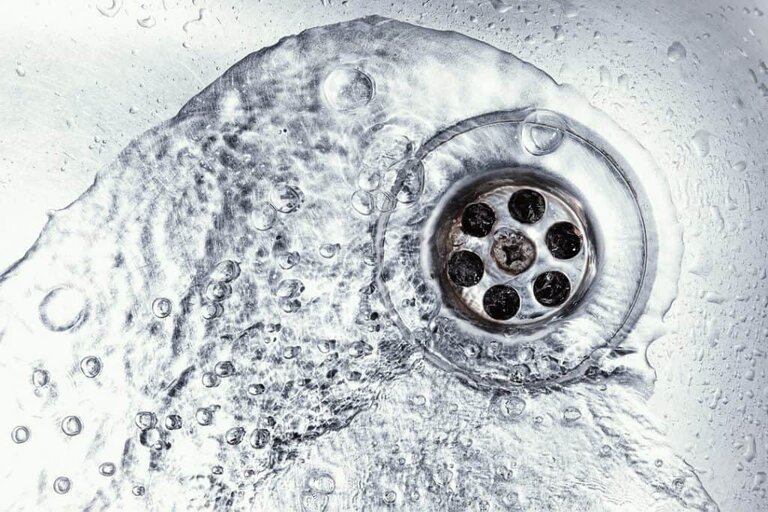Drano is non-corrosive and only eats away at organic material. Due to this, Drano can be left overnight in a drain without any issues. While that’s true, Drano often only requires a maximum of 30 minutes to work.
Drano is a famous brand of cleaning products and their clog removers can quickly fix your plumbing nightmare. With such an effective cleaner, it makes sense to wonder if you can leave Drano in the drain for too long.
Thankfully, there is no need to rush home if you’ve poured it down your drain and forgotten about it. Drano is perfectly safe to be left in a drain for prolonged periods. Here we’ll look at exactly how long you can leave it and answer all of the important questions. Let’s get started.

How Long Can Drano Be Left In The Drain?
Drano doesn’t give any specific guidance on how long it can be left in the drain. This is mainly because there is nothing in it to suggest that it can’t be left indefinitely. Drains are designed to be extremely durable and can easily cope with Drano for a long time. .
Many people wonder whether they can leave Drano while they are at work or while they are sleeping overnight. The answer to both of these suggestions would be the same, it’s nothing to be concerned about.
While you can leave Drano for a long time, it’s best to wash it away within 12 hours as it’s such a potent de-clogger but don’t be worried if you leave it for longer than this.
Are All Drano Products The Same?
You’re sure to run into a clogged drain or toilet at some point. Drano is widely regarded as the best drain cleaning product to unclog those drains in a matter of minutes. When poured down a drain, Drano will dissolve and decompose any materials that might be clogging your pipes.
Drano offers products for every type of cleaning requirement. Currently, there are nine different types of products from Drano. These include gels, liquids, granules, and foamers.
All of them are designed for specific tasks but in terms of how long they can be left in your drain, the information here applies to all of them.
If you want a fast solution to your clogging problem, you should use Drano Clog Remover. It contains chemicals that remove hair, soap scum, and dirt rapidly without being corrosive to metal or damaging to plastic pipes.
Unlike other Drano products, Drano Dual-Force Foamer also contains hydrogen peroxide, a foaming agent. The foam fills the pipe, clears the walls, and dissolves the clog.
Drano Hair Buster Gel or the Drano Snake Plus Tool + Gel System are excellent for clearing tough hair clogs in the shower.
These products aren’t the same and the right one will depend on the type of clog, where it is, and how thick it is. Whichever one you use, you won’t need to worry about leaving the declogging solution in the drain for too long.
Can I leave Drano overnight?

Drano is prevalent in many US households because it is safe to use, even for a novice cleaner. It has the ability to clear your clogged drain in as little as 15 minutes.
Also, using Drano is much cheaper than hiring a professional to look at the drain clog. Open the bottle and pour the product down the drain and let it do its magic.
Before using Drano, all you have to do is carefully read and follow the product’s instructions. There’s no risk of leaving Drano in your sink overnight but it’s always a good idea to check the bottle for any specific details.
The Dangers of Using Drano
You can use Drano as often as you need to. Due to how it works and what it does, it’s unlikely that you’ll need to use it twice within a short period. If you do, or if you didn’t manage to unclog the drain the first time, you can use it again without any issues.
The Drano’s chemical makeup is designed to oxidize the blockage and dissolve it. The primary oxidation process generates heat.
The product will sit on the pipe or porcelain if used in a toilet and in the right circumstances, this heat can crack weak porcelain so that’s something you should be wary of.
Drano should not be used with a plunger for safety reasons because you risk getting some of the product on your skin. Should not come into touch with your skin or eyes then you need to wash it off straight away.
While we’ve talked about how easy Drano is to use, it still contains dangerous chemicals and therefore precautions should be taken. If you take these precautions then there’s no reason you can’t use Drano time and time again.
Does Drano Damage Pipes?

No, Drano is non-corrosive to pipes and plumbing. Drano solutions are strong enough to remove stubborn clogs, but they won’t harm your plastic or metal pipes, so you don’t have to be concerned.
While Drano may work to unclog a clogged sink, it may just be a band-aid solution if you have more severe plumbing issues. If you keep using Drano to clear a chronic clog, then it’s a sign of a bigger issue that needs addressing.
If you do not want to use Drano, there are multiple alternatives on the market. However, no matter what drain cleaner you use, make sure it does not contain harmful and corrosive chemicals.
When mishandled, acidic chemical cleaners, which include sulfuric acid or hydrochloric acid, can destroy porcelain, metal, and any other material.
The only risk with Drano is that it can generate a significant amount of heat which can be a problem for porcelain which is why you shouldn’t put it down your toilet. For a clogged toilet, it’s much better to use a plunger or a toilet auger.
What happens if Drano doesn’t drain?
If your Drano doesn’t work then it’s usually an indicator that you have a serious clog issue which may require some other methods. One of these methods is a solution you can try using household products.
Pour 1/2 cup of baking soda down the drain if Drano doesn’t work. Wait for a solid 5 minutes before pouring 1 cup of vinegar down the drain pipes. You should remove all of the standing water before you start this process. The two substances react together and may be able to clear the clog. If they don’t, then there are other things that you can try.
If you feel comfortable enough in doing so, you can unscrew the waste trap and see if you can access the clog from there. While this is relatively simple to do, we’d only recommend this if you are competent at DIY as you may damage your pipes or not put them back correctly if you’re not sure what you’re doing.
We’ve mentioned that a plunger can be a good idea if you have a blocked toilet but it can also be used for any type of drain. Plunge down onto the drain and see if that is able to shift the blog.
If you can’t, then you may want to invest in a plumbing snake. These are highly effective but can be a little expensive. Due to that cost, you may want to look at the last option instead, which is calling a plumber.
They will be the experts and should be able to clear the drain quickly using their specialized tools and expertise.
Drano’s ingredients may not be able to clear all obstructions but it’s a good first step to try. It’s always best to try and unclog your drain as soon as you see a slight problem rather than waiting for it to be a bigger issue.
How Does Drano Work?
Drain cleaners come in three varieties: enzymatic, caustic, and acidic. Enzymatic is a “green choice” since it “eats” the clog with bacteria that create enzymes.
On the other hand, caustic or acidic drain cleaners employ harsh ingredients like sodium hydroxide or acid to clear a clog.
Drano isn’t acidic at all.
It’s characterized as a caustic drain cleaner because it contains chemicals like lye and sodium hydroxide.
Drano clears clogs by releasing a unique combination of sodium hydroxide, sodium metasilicate, and sodium hypochlorite (bleach).
Drano’s lye decomposes physical stuff in your pipes first. The aluminum in Drano then combines with the lye, raising the temperature in your pipes to near boiling, speeding up the decomposition process.
Finally, the lye produces a soapy substance that dissolves the stuck material, allowing water to wash it away.
While the chemicals in Drano are designed to eat away at whatever is obstructing your pipes, their potency can cause damage to any weak points. Drano will sit on top of the clog when your pipes become clogged, reacting and producing heat continuously until the clog dissolves.
While Drano is dissolving your blockage, that heat could cause issues with low-quality piping or glue. If you’ve had a professional drain installation, then Drano isn’t going to cause any issues.
FAQs On How Long Can You Leave Drano In Your Drain
Which is better, Drano or Liquid Plumr?
Liquid-Plumr Gel Clog Remover was designed to dissolve through standing water and clear drain obstructions. From the Drano family of goods, Max Gel Clog Removal is a similar product and there isn’t much difference between them.
What is the best drain cleaner for slow drains?
Drano Max Gel Clog Remover is undoubtedly the best all-in-one solution for all drain clogging needs. It can be used with both small and large pipes. Drano can readily clear clogs caused by soap scum, hair in the tub, or fat from foods in the kitchen sink.
How long does it take for Drano Max Gel to work?
Apply the product to clogged or slow-running drains and wait 15 minutes before flushing with hot water. Allow 30 minutes before flushing if you have a serious clog. Drano should not be used if you have recurring blockages. It’s an excellent solution for infrequent clogs, and it works quickly.